Nazareth
The Town that Theology Built
The Lost City
The Gospels tell us that Jesus’s home town was the ‘City of Nazareth’ (‘polis Natzoree’).
The gospels do not tell us much about this ‘city’ – it has a synagogue, it can scare up a hostile crowd (prompting JC’s famous “prophet rejected in his own land” quote), and it has a precipice – but the city status of Nazareth is clearly established, at least according to that source of nonsense called the Bible.
And in the sixth month the angel Gabriel was sent from God unto a CITY of Galilee, named Nazareth, To a virgin espoused to a man whose name was Joseph, of the house of David; and the virgin’s name was Mary.
(Luke1.26,27)And all went to be taxed, every one into his own city. And Joseph also went up from Galilee, out of the CITY of Nazareth, into Judaea, unto the city of David, which is called Bethlehem; because he was of the house and lineage of David:
(Luke 2.3,4)But when he heard that Archelaus did reign in Judaea in the room of his father Herod, he was afraid to go thither: notwithstanding, being warned of God in a dream, he turned aside into the parts of Galilee: And he came and dwelt in a CITY called Nazareth: that it might be fulfilled which was spoken by the prophets, He shall be called a Nazarene.
(Matthew 2.22,23)And when they had performed all things according to the law of the Lord, they returned into Galilee, to their own CITY Nazareth. And the child grew, and waxed strong in spirit, filled with wisdom: and the grace of God was upon him.
(Luke 2.39,40)
However when we look for historical confirmation of this hometown of a god – surprise, surprise! – no other source confirms that the place even existed in the 1st century AD.
• Nazareth is not mentioned even once in the entire Old Testament. The Book of Joshua (19.10,16) – in what it claims is the process of settlement by the tribe of Zebulon in the area – records twelve towns and six villages and yet omits any ‘Nazareth’ from its list.
• The Talmud, although it names 63 Galilean towns, knows nothing of Nazareth, nor does early rabbinic literature.
• St Paul knows nothing of ‘Nazareth’. Rabbi Solly’s epistles (real and fake) mention Jesus 221 times, Nazareth not at all.
• No ancient historian or geographer mentions Nazareth. It is first noted at the beginning of the 4th century.
None of this would matter of course if, rather like at the nearby ‘pagan’ city of Sepphoris, we could stroll through the ruins of 1st century bath houses, villas, theatres etc. Yet no such ruins exist.
‘Never heard of the place’ – Josephus
In his histories, Josephus has a lot to say about Galilee (an area of barely 900 square miles). During the first Jewish war, in the 60s AD, Josephus led a military campaign back and forth across the tiny province. Josephus mentions 45 cities and villages of Galilee – yet Nazareth not at all.
Josephus does, however, have something to say about Japha (Yafa, Japhia), a village just one mile to the southwest of Nazareth where he himself lived for a time (Life 52).
A glance at a topographical map of the region shows that Nazareth is located at one end of a valley, bounded on three sides by hills. Natural access to this valley is from the southwest.
Before the first Jewish war, Japha was of a reasonable size. We know it had an early synagogue, destroyed by the Romans in 67 AD (Revue Biblique 1921, 434f). In that war, it’s inhabitants were massacred (Wars 3, 7.31). Josephus reports that 15,000 were killed by Trajan’s troops. The survivors – 2,130 woman and children – were carried away into captivity. A one-time active city was completely and decisively wiped out.
Now where on earth did the 1st century inhabitants of Japha bury their dead? In the tombs further up the valley!
With Japha’s complete destruction, tomb use at the Nazareth site would have ended. The unnamed necropolis today lies under the modern city of Nazareth.
At a later time – as pottery and other finds indicate(see below) – the Nazareth site was re-occupied. This was after the Bar Kochba revolt of 135 AD and the general Jewish exodus from Judea to Galilee. The new hamlet was based on subsistence farming and was quite unrelated to the previous tomb usage by the people of Japha.
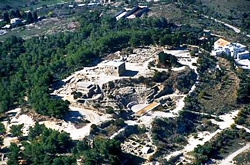
Sepphoris – an ersatz Nazareth?
No, not Nazareth but Sepphoris (Diocaesarea), a 45-minute walk away – and which does not get a mention in the gospels!
Credulous believers sometimes suggest that Jesus may have worked (with his father!) on the town’s construction or even attended the theatre in Sepphoris (hypocrite, after all, is a Greek word for actor!). Contrariwise, others suggest that the “Torah-abiding Jesus” avoided the town because of its corrupting Hellenism. These mutually exclusive explanations are feeble attempts to solve the “puzzle” of why the gospels fail to mention the “capital” of Galilee.
In reality, in the early 1st century, Sepphoris was no larger than several acres, an erstwhile Herodian palace-town destroyed by Varus, the Roman governor of Syria, in 4 BC. Sepphoris reemerged as an ill-planned townlet during the time of Antipas. Only in the late 1st and 2nd centuries, particularly after the Jewish wars, did a vibrant, Romanised Sepphoris emerge, with theatres, bath houses and all the other amenities of pagan civilisation.
Downsizing
In short order, Christian apologists fall over themselves to explain, ‘But of course, no one had heard of Nazareth, we’re talking of a REALLY small place.’ By semantic downsizing, city becomes TOWN, town becomes VILLAGE, and village becomes ‘OBSCURE HAMLET’.
Yet if we are speaking of such an obscure hamlet the ‘Jesus of Nazareth’ story begins to fall apart.
For example, the whole ‘rejection in his homeland’ story requires at a minimum a synagogue in which the godman can ‘blaspheme.’ Where was the synagogue in this tiny bucolic hamlet? Why was it not obvious to the first pilgrims like Helena (see below) – it would, after all, have been far more pertinent to her hero than a well? In reality, such a small, rustic community could never have afforded its own holy scrolls, let alone a dedicated building to house them. As peasant farmers almost certainly they would have been illiterate to a man.
If JC had grown up and spent thirty years of his life in a village with as few as 25 families – an inbred clan of less than 300 people – the ‘multitude’ that were supposedly shocked by his blasphemy and would have thrown him from a cliff, would not have been hostile strangers but, to a man, would have been relatives and friends that he had grown up with, including his own brothers. Presumably, they had heard his pious utterances for years.
Moreover, if the chosen virgin really had had an annunciation of messiah-birthing from an angel the whole clan would have known about it inside ten minutes. Just to remind them, surely they should also have known of the ‘Jerusalem incident’ (Luke 2.42-49) when supposedly the 12-year-old proclaimed his messiahship?
Indeed, had no one mentioned what had happened in Bethlehem – star, wise men, shepherds, infant-massacre and all? Why would they have been outraged by anything the godman said or did? Had they forgotten a god was growing up in their midst? And what had happened to that gift of gold – had it not made the ‘holy family’ rich?
If Nazareth really had been barely a hamlet, lost in the hills of Galilee, would not the appellation ‘Jesus of Nazareth’ have invoked the response ‘Jesus of WHERE?’ The predictable apologetic of quoting gospel John (“Can anything good come out of Nazareth?” – 1.46) implies that the questioner, Nathanael, had indeed “heard of” the vanishing small hamlet (Nathanael was supposedly a local boy from Cana). But would anyone outside of Galilee have recognized the name?
Then again, if Nazareth had really been a tiny hamlet, the nearest convenient ‘mountain’ from which the god-man could have been thrown – a cliff edge (Luke 4.28-30) – would have been 4 km away, requiring an energetic climb over limestone crags. Would the superman really have been frog-marched so far before ‘passing through the midst of them’ and making his escape?
Of course, all these incongruities exist because the ‘Jerusalem incident’ and the whole nativity sequence were late additions to the basic messiah-in-residence story.
Be that as it may, was there even a tiny village?
The archaeological evidence?
The world has been blessed by the fact that excavation at Nazareth has been conducted by Catholic archaeologists. In an earlier age they may well have “found” sandals neatly inscribed with “property of Jesus Christ”. As it is, they diligently extract every last drop of sanctity from some pretty meagre findings. Yet for all their creative interpretations even the Franciscans cannot disguise the fact that the lack of evidence for a pre-Jesus village at the Nazareth site is virtually total.
Not that the Franciscans have lacked the opportunity to find what they want to find; they have, in fact, been in Palestine for several centuries, official custodians of the ‘Holy Land’ as a result of Papal Bulls ‘Gratias agimus’ and ‘Nuper charissimae’ issued by Clement VI in 1342.
During the Crusaders’ wars, Nazareth had changed hands several times. At one point (1099) the Norman-Sicilian adventurer Tancred had set up a ‘principality of Galilee’ with Nazareth as his capital. But the Christians were repeatedly kicked out until finally, in 1263, Nazareth was completely devastated by Sultan Baibars and the whole area left desolate for nearly 400 years.
The Franciscans got back into the area under a deal with Fakhr ad-Din II, emir of Lebanon, in 1620. They reoccupied the remains of the crusader fort but found Greek monks still in possession of ‘Mary’s Well’ . With funds flowing in they took over the town administration and in 1730 built a church over the Grotto. The demolition of this structure in 1955 paved the way for ‘professional’ archaeology, and the ‘discovery’ of the Biblical Nazareth in the very grounds of the Church itself!

Christian Hero No 1. 1955-1960 Excavations conducted by Father Bellarmino Bagatti (Professor, Studium Biblicum Franciscanum at Flagellation, Jerusalem). Beneath his own church and adjoining land, Bagatti discovered numerous caves and hollows. Some of these caves have obviously had a great deal of use, over many centuries. Most are tombs, many from the Bronze Age. Others have been adapted for use as water cisterns, as vats for oil or as ‘silos’ for grain. Apparently, there were indications that Nazareth had been ‘refounded’ in Hasmonean times after a long period when the area had been deserted. Yet overwhelmingly, archaeological evidence from before the second century is funerary. Obliged to admit a dearth of suitable evidence of habitation, none the less, Bagatti was able conclude that 1st century AD Nazareth had been ‘a small agricultural village settled by a few dozen families.’
With a great leap of faith the partisan diggers declared what they had found was ‘the village of Jesus, Mary & Joseph’ – though they had not found a village at all, and certainly no evidence of particular individuals. The finds were consistent, in fact, with isolated horticultural activity, close to a necropolis of long-usage.
Rather conveniently for the Catholic Church, questionable graffiti also indicated that the shrine was dedicated to the Virgin Mary, no less!
Yet one point is inescapable: the Jewish disposition towards the ‘uncleanliness’ of the dead. The Jews, according to their customs, would not build a village in the immediate vicinity of tombs and vice versa. Tombs would have to be outside any village.
“The tombs, both those discovered by Bagatti and others known from earlier explorations, would have been placed outside the village and serve, in fact, to delimit its circumference for us. Looking at their locations on the plans drawn up by Bagatti (1.28) or Finegan (27), one realizes just how small the village actually was …“
– J.D. Crossan, The Historical Jesus.
But just how small can we get before giving up on a ‘village’? The presence of numerous rock-cut tombs that close to the ‘grotto’ is evidence that, in the 1st century, in that area, there was no village. The area was not inhabited, even if it was used.

Christian Hero No 2. 1996 -1997 Dr. Pfann (Franciscan School of Theology) digs at Nazareth. In November 1996 Stephen Pfann of the Center for the Study of Early Christianity began an investigation of agricultural terraces in the grounds of Nazareth Hospital. What Pfann and his crew came up with was a vaguely-dated winepress, described as ‘ancient’. Potsherds were also found on the surface of the terraces, dating from various periods ‘beginning with the early to late Roman periods.’
An archaeological survey of the surface of the land adjacent to Nazareth Hospital was conducted between February and May 1997 by Pfann and a team, all from the Center for the Study of Early Christianity. Two distinct areas were identified which are defined by the type of terracing found there. Yet dating by traditional stratification was not possible.
With typical Christian zeal Pfann was able to conclude that ‘Nazareth was tiny, with two or three clans living in 35 homes spread over 2.5 hectares’. It was just unfortunate that all evidence of the homes was razed by later invaders.
In truth, the scanty evidence is consistent with the site being used as a single family farm over many centuries – and a single family farm does not make a village.
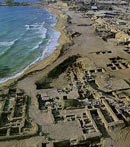
History and archaeology actually begin to coincide with the discovery of a fragment of dark gray marble at a synagogue in Caesarea Maritima in August 1962. Dating from the late 3rd or early 4th century the stone bears the first mention of Nazareth in a non-Christian text. It names Nazareth as one of the places in Galilee where the priestly families of Judea migrated after the disastrous Hadrianic war of 135 AD. Such groups would only settle in towns without gentile inhabitants, which ruled out nearby Sepphoris. Apparently, the priests had been divided from ancient times into twenty-four ‘courses’ that took weekly turns in Temple service. The restored inscription reads
The eighteenth priestly course [called] Hapizzez, [resettled at] Nasareth.’
– J.D. Crossan (The Historical Jesus)
A few Jewish priests and their families made up a small settlement in the southeast of the valley until the 4th century. Quite probably, they extended and re-used some of the ancient necropolis tombs. The Jewish hamlet was then supplanted by the Christian presence slightly further north, by ‘Mary’s Well’.
One might speculate that Christian control of the village’s sole water source eventually drove the perfidious Jews away, thus allowing the Greek monks to take over the 2nd century synagogue – now known as the ‘synagogue-church’ – sometime in the 4th century when Christianity got the official stamp of approval. A town grew up at the site, causing the abandonment and destruction of any more ancient Jewish dwellings which, as in Capernaum, were most probably built without foundations. Some Jews subsequently re-settled in the valley, for we know that they were expelled again from the area in the 7th century for collaboration with the Persians.
Getting a Name
The expression ‘Jesus of Nazareth’ is actually a bad translation of the original Greek ‘Jesous o Nazoraios’ (see below). More accurately, we should speak of ‘Jesus the Nazarene’ where Nazarene has a meaning quite unrelated to a place name. But just what is that meaning and how did it get applied to a small village? The highly ambiguous Hebrew root of the name is NZR.
The 2nd century gnostic Gospel of Philip offers this explanation:
‘The apostles that came before us called him Jesus Nazarene the Christ …”Nazara” is the “Truth”. Therefore ‘Nazarene’ is “The One of the Truth” …’
– Gospel of Philip, 47.
What we do know is that ‘Nazarene’ (or ‘Nazorean’) was originally the name of an early Jewish-Christian sect – a faction, or off-shoot, of the Essenes. They had no particular relation to a city of Nazareth. The root of their name may have been ‘Truth’ or it may have been the Hebrew noun ‘netser‘ (‘netzor’), meaning ‘branch’ or ‘flower.’ The plural of ‘Netzor’ becomes ‘Netzoreem.’ There is no mention of the Nazarenes in any of Paul’s writings, although ironically, Paul is himself accused of being a Nazorean in Acts of the Apostles. The reference scarcely means that Paul was a resident of Nazareth (we all know the guy hails from Tarsus!).
‘For finding this man a pest, and moving sedition among all the Jews throughout the world, and a leader of the sect of the Nazaraeans.’ – Acts 24.5. (Darby Translation).
The Nazorim emerged towards the end of the 1st century, after a curse had been placed on heretics in Jewish daily prayer.
‘Three times a day they say: May God curse the Nazarenes’.
– Epiphanius (Panarion 29.9.2).
The Nazarenes may have seen themselves as a ‘branch from the stem of Jesse (the legendary King David’s father)’. Certainly, they had their own early version of ‘Matthew’. This lost text – the Gospel of the Nazarenes – can hardly be regarded as a ‘Gospel of the inhabitants of Nazareth’!
It was the later Gospel of Matthew which started the deceit that the title ‘Jesus the Nazorene’ should in some manner relate to Nazareth, by quoting ‘prophecy’:
“And he came and dwelt in a city called Nazareth: that it might be fulfilled which was spoken by the prophets, He shall be called a Nazarene.”
– Matthew 2.23.
With this, Matthew closes his fable of Jesus’s early years. Yet Matthew is misquoting – he would surely know that nowhere in Jewish prophetic literature is there any reference to a Nazarene. What is ‘foretold’ (or at least mentioned several times) in Old Testament scripture is the appearance of a Nazarite. For example:
“For, lo, thou shalt conceive, and bear a son; and no razor shall come on his head: for the child shall be a Nazarite unto God from the womb: and he shall begin to deliver Israel out of the hand of the Philistines.”– Judges 13.5.
Matthew slyly substitutes one word for another. By replacing Nazarite (‘he who vows to grow long hair and serve god’) with a term which appears to imply ‘resident of’ he is able to fabricate a hometown link for his fictitious hero.
So how did the village get its name?
It seems that, along with the Nozerim, a related Jewish/Christian faction, the Evyonim – ‘the Poor’ (later to be called Ebionites) – emerged about the same time. According to Epiphanius (Bishop of Salamis , Cyprus, circa 370 AD) they arose from within the Nazarenes. They differed doctrinally from the original group in rejecting Paul and were ‘Jews who pay honour to Christ as a just man…’ They too, it seems, had their own prototype version of Matthew – ‘The Gospel to the Hebrews’. A name these sectaries chose for themselves was ‘Keepers of the Covenant’, in Hebrew Nozrei haBrit, whence Nosrim or Nazarene!
In other words, when it came to the crunch, the original Nazarenes split into two: those who tried to re-position themselves within the general tenets of Judaism (‘Evyonim’-Nosrim); and those who rejected Judaism (‘Christian’-Nosrim)
Now, we know that a group of ‘priestly’ families resettled an area in the Nazareth valley after their defeat in the Bar Kochbar War of 135 AD (see above). It seems highly probable that they were Evyonim-Nosrim and named their village ‘Nazareth’ or the village of ‘The Poor’ either because of self-pity or because doctrinally they made a virtue out of their poverty.
“Blessed are the Poor in spirit for theirs is the kingdom of Heaven.”
– Matthew 5,3.
The writer of Matthew (re-writer of the proto-Matthew stories) heard of ‘priestly’ families moving to a place in Galilee which they had called ‘Nazareth’ – and decided to use the name of the new town for the hometown of his hero.
Dodgy Story, Dodgy Geography
The original gospel writers refrained from inventing a childhood, youth or early manhood for JC because it was not necessary to their central drama of a dying/reborn sun-god. But as we know, the story grew with the telling, particularly as the decades passed and the promised redeemer and judge failed to reappear. The re-writer of the Gospel of Mark, revising the text sometime between 140 and 150 AD, introduced the name of the city only once, in chapter one, with these words:
“And it came to pass in those days, that Jesus came from Nazareth of Galilee and was baptized by John at the Jordan.”
– Mark I, 9.
Ironically, an indication that this sole reference to a town called Nazareth in Mark is a late, harmonization interpolation is to be found in the Gospel of Matthew. Copying the same baptism episode from an early edition of Mark, the author of Matthew makes no mention of Nazareth:
“Then Jesus came from Galilee to John at the Jordan to be baptized by him.” – Matthew 3.13.
In the Greek New Testament no fewer than eleven variant spellings are used for Nazarene, Nazarean and Nazareth. In total the words occur thirty-one times. Though you would never guess from the English translations, on nineteen occasions Nazarene or Nazarean, not Nazareth, is intended. And in the Gospel of Mark, all four later occurences (1.24; 16.6; 10.47;14.67) the word used is Nazarene, not Nazareth.
Clearly, “Jesus the Nazarene” in the original tale became “Jesus, a resident of Nazareth” in the updated story of Matthew and Luke. Indeed, there are indications that an early layer in the development of Mark favoured Capernaum as the hometown of Jesus (home of the six most prominent disciples, venue for several key miracles, etc.).
We can trace the subsequent elevation of Nazareth in the Gospel of Luke. Luke is the writer who emphasizes JC’s ties to ‘Nazareth.’ Luke is the writer who goes out of his way to demonstrate an anti-Capernaum stance. Scholars have concluded Luke was not a Jew himself because of his ‘glaring errors in things Jewish’. He also makes mistakes in his geography. He knows little about the place and in his mini-drama describes an impossible incident:
” … and brought him to the precipice of the mountain that their city was built upon.” – Luke 4.29.
Nazareth, in fact, is located in a depression, set within gentle hills. The whole region is characterized by plains and mild rises with no sharp peaks or steep cliffs. The terrain is correctly understood as a high basin, for in one direction is the much lower Plain of Esdraelon. But there is no disguising Nazareth is built in a valley and not on a mountain. Even the mediaeval town sat below the summit – protected from the wind. Beginning only in 1957, the Jewish suburb called ‘Nazerat Illit’ (‘Upper Nazareth’) was built to the top of the hills to the east of the city.
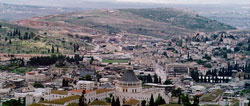
Foreground
(below that pointy building): – supposed location of 1st century ‘city’ of Nazareth
Background & right:
‘Mount of Precipice‘ (aka ‘Lord’s Leap’)
“When they heard these things, all in the synagogue were filled with wrath. And they rose up and drove him out of the town and brought him to the brow of the hill on which their town was built, so that they could throw him down the cliff. But passing through their midst, he went away.” – Luke 4.28-30.
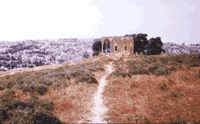
Perhaps the Multitude might really have threatened to roll JC down the slope?
It would take quite some time to get from the downtown ‘synagogue’ and scramble to the top of the ‘cliff’!
The Town that Theology Built
In the 3rd century Church Father Origen knew the gospel story of the city of Nazareth – yet had no clear idea where it was – even though he lived at Caesarea, barely thirty miles from the present town! Even in Origen’s day, as the Church became more institutionalised, intense rivalry was developing between the patriarchs of Caesarea and Jerusalem. This rivalry was only resolved (in Jerusalem’s favour) at Chalcedon in 451. Part of the rivalry centred on control of ‘Holy places’. Hence, ‘finding’ the lost city of Nazareth was a matter of major importance,
Perambulating to the rescue, in the early 4th century, came the 80-year-old dowager Empress Helena. Preparing the way for an imminent meeting with her maker with a program of ‘Works’, she made a conscience-salving pilgrimage to Palestine. In the area of Nazareth she could find nothing but an ancient well – in fact the only water source in the area (which in itself demolishes the idea there was ever a ‘city’ ). No doubt encouraged by canny locals, Helena promptly labelled the hole in the ground ‘Mary’s Well’ and had a small basilica built over the spot. Conveniently, the gospels had failed to make clear exactly where Mary had been when the archangel Gabriel had come calling. Thus the Well site acquired local support for the divine visitation and Nazareth acquired its first church.
Helena created the pilgrimage business which has never ceased. Yet before the passage of the imperial grandee, not a single ancient source had established a precise location for the ‘Nazara’ of the gospels.
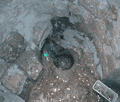
‘Mary’s Well’: A hole in the ground evidence for Holy Family (about as convincing as an empty tomb)
Note collection box for coins, lower right.
4th Century Pilgrim Route – and NO NAZARETH!
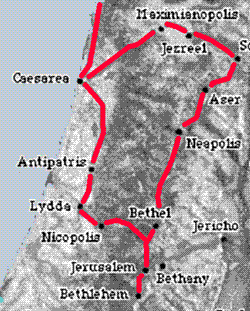
Itinerarium Burdigalense – the Itinerary of the Anonymous Pilgrim of Bordeaux – is the earliest description left by a pious tourist. It is dated to 333 AD. The itinerary is a Roman-style list of towns and distances with the occasional comment.
As the pilgrim passes Jezreel (Stradela) he mentions King Ahab and Goliath. At Aser (Teyasir) he mentions Job. At Neopolis his reference is to Mount Gerizim, Abraham, Joseph, and Jacob’s well at Sichar (where JC ‘asked water of a Samaritan woman’). He passes the village of Bethel (Beitin) and mentions Jacob’s wrestling match with God, and Jeroboam. He moves on to Jerusalem.
Our pilgrim – preoccupied with Old rather than New Testament stories – makes no single reference to ‘Nazareth.’
A generation after the dowager empress had gone touring, another geriatric grandee, the Lady Egeria, spent years in the ‘Land becoming more Holy by the day’.
Egeria – a Spaniard, like the then Emperor Theodosius and almost certainly part of the imperial entourage – reached the Nazareth area in 383. This time, canny monks showed her a ‘big and very splendid cave’ and gave the assurance that this was where Mary had lived. The Custodians of the Cave, not to be outbid by the Keepers of the Well, insisted that the cave, not the well, had been the site of the divine visitation. This so-called ‘grotto’ became another pilgrimage attraction, over which – by 570 – rose the basilica of another church. Today, above and about the Venerable Grotto, stands the biggest Christian theme park in the Middle East.
4th Century Roman Map – and NO NAZARETH!
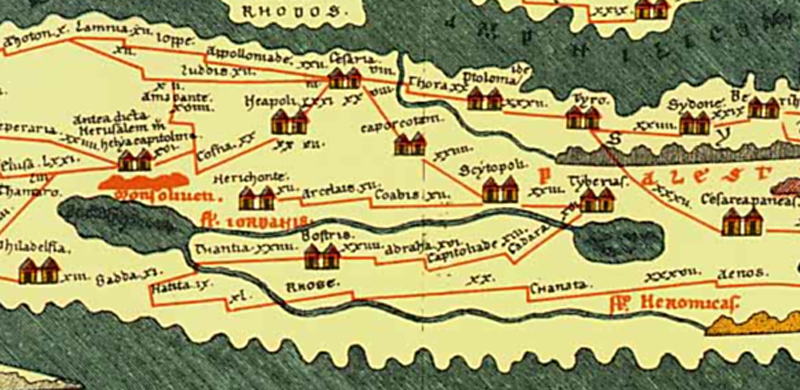
The Levantine coast from the so-called Peutinger map or “table” (Tabula Peutingeriana), with west to the top. The complete map is twenty-two feet wide and is so-named for Conrad Peutinger, a 16th century German antiquarian and is currently held in Vienna. The map is actually a medieval copy (12th or 13th century) of a 4th century Roman original (it shows Constantinople, founded in the year 328). The whole world known to the Romans is represented, from Spain in the west to India in the east.
In the section shown here, below the city of Aelia Capitolina (centre left), the map shows one site which had by this stage entered the Christian dreamscape – the Mount of Olives (red). The cartographer of this unique record named more than 3000 places. And guess what? – he does not mention Nazareth!

Grotto beneath Basilica of the Annunciation. Mary’s ‘maiden home’ (or even home of the holy family, if you prefer)
By the late 4th century – by which time the Church had control of theological correctness – Nazareth was being correctly described by Jerome as ‘a very small village in Galilee’ (Onom. 141:3). He should know: he had fled scandal in Italy to set up an ecclesiastical retreat in the area for well-heeled Romans. The village owed its very existence to the imperial itinerary half a century before.
By the 5th century the supposed site of Nazareth – marked by its couple of churches – had become a key destination for pious (and leisured) pilgrims. We know of a Piacenza visiting in 570, of an Arculf visiting in 638, a Wilhebald in 724, an Al Mas’udi in 943. Sewulf in 1102, like the earlier visitors, reported that only the annunciation church was to be seen.
In 636 Arab armies overran Byzantine possessions in Palestine, including Nazareth. A Christian presence continued in the area, though it was subject to restrictions and heavy taxes. Nearly five centuries later, Crusaders occupied the valley and built a fort. On the foundations of the earlier Byzantine ‘grotto’ church they built something a little grander, more befitting their resident bishop.
Old town Nazareth – an ecclesiastic theme-park
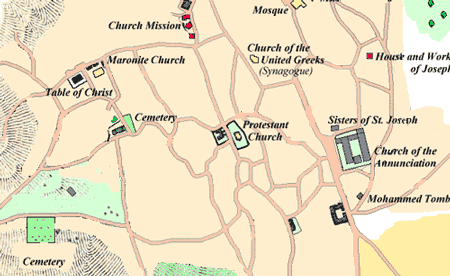
‘JesusWorld’
In the center of town, the huge Catholic Church of the Annunciation (largest church in the Middle East) built over numerous caves.
Up the hill, Church of St. Joseph built over other caves (‘carpenter’s house and workshop’).
Across the street, Sisters of Nazareth Hospice, built over ancient tombs, one with a huge rolling stone door!
Up the road, the Greek Catholic Church, next to an early synagogue
Today more than a million visitors (fifty per cent of tourists visiting Israel) call at Nazareth. Who would want to spoil the party? So perhaps keep it quiet …
The evidence for a 1st century town of Nazareth does not exist – not literary, not archaeological, and not historical. It is an imaginary city for an imaginary god-man.
Nazareth App
You could find out more about the city of Nazareth and it’s historical significance by downloading this android app play store link direct download link
Sources:
René Salm, The Myth of Nazareth (Kevalin, 2007)
Dan Cohn-Sherbok, The Crucified Jew (Harper Collins,1992)
Henry Hart Milman, The History of the Jews (Everyman, 1939)
Josephus, The Jewish War (Penguin, 1959)
Jonathan Reed, Archaeology and the Galilean Jesus: A Re-examination of the Evidence (Trinity, 2002)
Leslie Houlden (Ed.), Judaism & Christianity (Routledge, 1988
Karen Armstrong, A History of Jerusalem (Harper Collins, 1999)
Jonathan N. Tubb, Canaanites (British Museum Press, 1998)
Norman Cantor, The Sacred Chain – A History of the Jews (Harper Collins, 1994)
Good for Business
“Nazareth has many wonderful sights … Our facilities can accommodate visitors and conventioneers alike … an outstanding destination for visitors from all over the world …”
– Mayor of the City of Nazareth
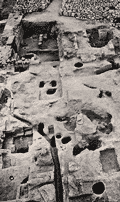
The 1955/68 Excavation at Nazareth – storage pits & votive lamps – enough for Franciscan archaeologists to declare Nazareth ‘the village of Jesus, Mary & Joseph’ and the site of ‘uninterrupted veneration’ by Christians.
Road to Nowhere
“Contrary to assertion, there is no evidence of a major road extending from Sepphoris through Nazareth, and on to Jerusalem. The evidence for an interregional Roman road from Sepphoris to Jerusalem through the central hill country and past Nazareth is late or post-Hadrianic and dates after the Bar Kochba Revolt.“
– Jonathan L. Reed, Archaeology and the Galilean Jesus: A Re-examination of the Evidence, p117.
The Archaeological Record:
Late and Middle Stone Age periods.
13 human skeletons and many artifacts unearthed in a cave at Mount of Precipice.
Middle-late Bronze (2000-1200 BC)
Remains of pottery from three tombs.
No non-funerary remains.
Iron (1200-586 BC)
— Some of these less numerous finds may be funerary, and some not. They come from caves in the vicinity of the Church of the Annunciation.
They were found in various ‘silos’ (cavities in the ground) and ‘from other places’ (unspecified) nearby. These remains include 5 vases, as well as jugs and jars (mostly fragments).
Babylonian and Persian periods (586-332 BC)
– No finds.
Hellenistic and Hasmonaean periods (332-37 BC)
— No finds.
Roman I (Herodian, 37 BC- 70 AD)
The remains from this period possibly include 6-10 oil lamps. (But they may date as late as 150 AD).
Of these, 4 are from Tomb 70 (near the Church of the Annunciation), 2 were found under the Church’s ‘grottos’, and 4 are from nearby places.
All are originally from tombs – consistent with the provenance of most of the surviving oil lamps of this period throughout Palestine.
Roman II (70-180 AD)
4 lamps from two tombs (Tomb 70, and a tomb 250 m. south of Church of the Annunciation).
Roman III (180-324 AD)
Seven lamps from the same two tombs as above.
From a late-Roman building, some plastered stones, remnants of a mosaiced floor, and a Roman coin of the mid-4th century.
Pottery and other ‘movable’ evidence (glass, etc.) – the preponderance from 3rd & 4th centuries AD, and some from 2nd century AD.
The 7 lamps all come from one and the same tomb (No. 70).
They were not spread out over an area suggesting the multiple locations associated with a ‘village’.
Nor were they in domestic use at the time of their placement in situ – they are all funerary votive lamps.
Misusing the evidence
Coins Found ...
